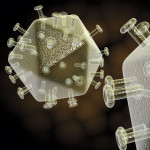Following in the footsteps of the encouraging results from Phase III studies of Istentress (MK-0518), researchers evaluating Gilead Science’s elvitegravir (GS-9137) took the podium at the 14th Conference on Retroviruses and Opportunistic Infections to share promising clinical trial data of their own. Sixteen and 24 week data from a Phase II study of the drug, with documented activity against multiple-drug-resistant HIV, indicate that this is another experimental integrase inhibitor to watch, especially for HIV-positive patients with limited treatment options.
All patients entered the study with an average viral load of 36,000 and approximately 11 mutations in their HIV conferring drug resistance to available PIs. Between 17% and 26% of patients were using Fuzeon for the first time in the study.
After eight weeks, the Data and Safety Monitoring Board for the study recommended closing the 20 mg elvitegravir group due to a high rate of virologic failure. Patients in this group were offered open-label 125 mg elvitegravir instead.
After 16 weeks in the study, the average viral load drop was 1.2 log in the control group, 1.5 in the 50 mg elvitegravir group, and 1.7 in the 125 mg elvitegravir group. The viral load reductions were similar after 24 weeks in the study. The 1.7 log drop in the 125 mg elvitegravir group after 16 and 24 weeks, compared to the 1.2 log drop in the control group at weeks 16 and 24, were statistically significant.
By week 24, 61% of patients in the control group saw their viral loads drop by at least 1 log at some point in the study; 51% saw their viral load drop by at least 2 log at some point. In the 50 mg elvitegravir group, 91% and 69% saw their viral loads drop by at least 1 or 2 log, respectively. In the 125 mg elvitegravir group, 92% and 76% saw evidence of a 1 or 2 log drop, respectively, at some point in the study. With the exception of the 2 log drop in the 50 mg elvitegravir group, the differences between the elvitegravir groups and the control groups were statistically significant.
Among patients who entered the study with no active HIV drug to include in their OBR – meaning evidence of resistance to all of the available NRTIs and PIs – the average viral load reduction was 0.7 log in the 125 mg elvitegravir group. But among those who had at least one active agent to include in their OBR, the average viral load drop after 24 weeks was 2.1 log.
Approximately 30% of patients in the control group had viral loads below 50 copies after 16 weeks, compared to 38% of patients in the 50 mg elvitegravir group and 40% of patients in the 125 mg elvitegravir group.
As for CD4 counts, an increase of 28 was seen in the control group after 16 weeks, compared to increases of 52 in the 50 mg elvitegravir group and 61 in the 125 mg elvitegravir group.
The study authors noted that, much like other experimental antiretrovirals being tested in treatment-experienced patients, the success of elvitegravir is highly dependent on the inclusion of OBR drugs that HIV is still sensitive to.
The rate of side effects leading to treatment discontinuation were low and similar between the study groups (1% to 3%). Moderate-to-severe “grade 3 and 4” side effects and laboratory abnormalities were also similar between the study groups.
The conclusion of the study was that the 50 mg and 125 mg elvitegravir groups were “non-inferior” to the control group after 24 weeks of treatment. The 125 mg group was shown to be statistically superior to the control group at both 16 and 24 weeks and Gilead plans to move a 150 mg twice-daily dose – achieving similar blood concentrations as the 125 mg dose – into Phase III clinical trials.






Comments
Comments